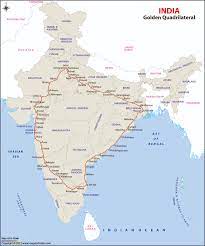Golden Quadrilateral Expressways – Connecting India
The Golden Quadrilateral Expressways have been developed for the fast economic development of the country. For the first time, India has seen this type of road also known as super highways or expressways. The Golden Quadrilateral Expressways connect the four Metropolitan cities of India namely, Delhi, Mumbai, Chennai, Kolkata, and back to Delhi. It is very interesting to know about the Golden Quadrilateral Expressways. Children of class X read this topic in Geography Lifelines of National Economy.
Highlights of Golden Quadrilateral Expressways
- The planning of this project was done in 1999.
- Construction work starts in 2001.
- These are 4 to 6-lane roads.
- The official completion of the project was in 2012.
- The total length of the quadrilateral road is 5846 km.
- Though the highways altogether account for just two percent of the country’s total road infrastructure, they carry 40% of the total national traffic.
60 Most Expected Geography Questions In Term I From Class X
Interesting Story Behind The Project
- It was a dream project of former Prime Minister Atal Bihari Vajpayee.
- India was in debt of 5656 billion dollars.
- When the proposal of the Golden Quadrilateral was tabled in the parliament, the opposition made fun of the government.
- It was because India was in debt and the government was planning a project of 600 billion rupees.
- The government was serious and wanted to pace the economic development of the country.
30 GEOGRAPHY NTSE QUESTIONS – You Need To Read This First
Top 8 Benefits Of Golden Quadrilateral Expressways
- It will save travel time by 25 percent.
- will help in the industrial growth of the towns through which it passes.
- agricultural produce and be transported easily from remote areas to major cities and ports.
- will provide employment opportunities in the construction of roads as well as demand for steel, cement, and other minerals.
- Reduces traffic jams.
- saves time.
- improves safety by reducing road accidents.
- Low maintenance cost and fuel efficiency as fuel consumption are higher on bad roads.
7 Geography questions from Resources and Development that can trouble class X students
Special Features Of Golden Quadrilateral Expressways
- Roads are broad with 4 to 6 lanes.
- There is no speed breaker or obstacle for the smooth movement of vehicles.
- Basic facilities like toilets, dhaba (hotels), and petrol pumps are available on the roadside.
- Roads have street lights which ensure both visibility and speed.
How These Roads Were Constructed?
- As the government of India was not having money and India was in huge debt, the government outsourced the project.
- Many big companies like Larsen & Toubro, and LG Engg. & Construction, Nagarjuna Construction, Consortium of GVK International and BSCPL, IRCON International, Punj Lloyd, Progressive Construction, ECSB-JSRC, B. Seenaiah & Co. etc. have made these roads.
- The foundation of the road was laid by digging 8 to 10 feet.
- Moreover, the Government asked the companies to invest money in the construction of roads.
- In return, after the completion of the road, the companies can collect toll tax for the next 15 years to get their invested money back.
- So, it will be the responsibility of the company to see the maintenance of the roads as well for the next 15 years.
- After 15 years, it will be handed over to the government.
- Therefore, these super highways were built on the concept of BOT.
- BOT stands for Build, Operate, and Transfer.
- It means, the company constructing the road will be responsible for building the road, Operating means maintenance of the road and finally transferring it to the government after the completion of 15 years.
Questions Based On Golden Quadrilateral Expressways
Q1. Which of the following National Highways forms a part of the Golden Quadrilateral Highway Project?
A. NH 1 B. NH 7 C. NH 17 D. NH 206
Q2. How much was the expected cost of this project?
A. RS. 200 BILLION B. RS 400 BILLION C. RS 600 BILLION D. RS. 800 BILLION.
Q3. The actual amount spent to complete the project was _______________.
A. RS108 BILLION B. RS 208 BILLION C. RS 308 BILLION D. RS. 408 BILLION.
Q4. When was the whole Golden Quadrilateral Project fully operational?
A. January 2000 B. January 2004 C. January 2008 D. January 2012
Q5. Golden Quadrilateral expressway accounts for what percent of the country’s total road infrastructure?
A. 2 % B. 4 % C. 6 % D. 8 %
Q6. What percentage of the country’s traffic is carried by the Golden Quadrilateral expressway?
A. 10 % B. 20 % C. 30% D. 40 %
Q7. The Indian highways are maintained by __________________?
A. BRO B. NHDP C. NHAI D. CPWD
Q8. Which Indian Prime Minister initiated the Golden Quadrilateral Expressway?
A. Indira Gandhi B. Atal Bihari Vajpayee C. Chandrashekhar D. V.P. Singh.
Q9. What is the total length of the Golden Quadrilateral road?
A. 5846 KM B. 8564 KM C. 4685 KM D. 6485 KM
Q10. Which two terminating stations are mentioned wrong?
A. Delhi – Mumbai B. Mumbai – Chennai C. Chennai – Kolkata D. Kolkata – Lucknow
Conclusion:
The Golden Quadrilateral Project perhaps was the first honest step by the government of India for the country’s development. Although the estimated cost of the project was Rs. 600 billion but got completed in almost Rs. 308 Billion. Usually, the budget exceeds the estimated cost but here the project was completed within half of the budget. The Golden Quadrilateral Expressways project was initiated at a time when the country was in huge debt. Such projects and initiatives increase the pace of development. Golden Quadrilateral Expressways is definitely a landmark for the country.
You may like to read:
Class X Geography board exam revision with map
60 Most Expected Geography Questions In Term I From Class X





0 Comments